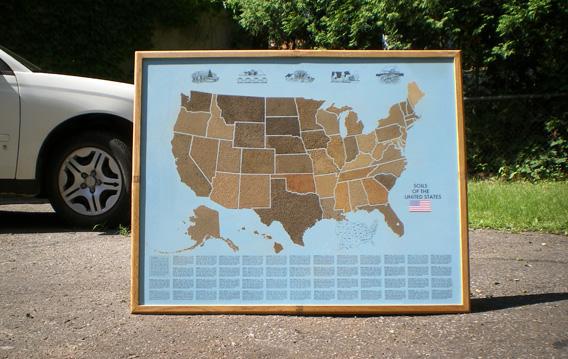Les Gregor was working outdoors with a piece of MACtac—an adhesive he uses in his art projects—when it fell to the ground, sticky side down. He picked it up and saw that it now had a thin, uniform layer of sand coating its surface. And here was the eureka moment.
Suddenly, Gregor envisioned a map of the United States in which each state would be shaped out of a chunk of soil native to that state. He sent letters to all 50 departments of agriculture, requesting soil samples. Coincidentally, Hawaii and Alaska were first to respond. Every other state soon followed suit. Except for Kansas, which said there was a law that forbade it from mailing soil. Gregor found an accomplice in Wichita who was willing to live dangerously.
He laid out his template. Glued down his soils. Added some salient text about their relative compositions. And voilà: A Soil Map of the United States of America. When I heard about his creation, I was intrigued. I’d already reviewed a book about obsessive map nerds and, separately, declared a U.S. map designed by one guy in Oregon the greatest ever made. Here was what seemed to be an altogether new map phenomenon. I needed to know more.
When I got in touch with Gregor, he explained that he asked each state for a “representative” soil. Many sent their official state soils—which, wow, who knew that was a thing? Michigan sent two soils, so Gregor blended them together. Other soils came in clumps that he had to sift.
His favorite soils came from Colorado (“quite reddish”), Maine (“pale and sandy”), and Mississippi and Alabama ("deeply colored with iron oxide”). There are varying degrees of acidity. Every soil is a slightly different color. “It makes a nice quilt,” says Gregor.
It’s never-ending, this quest to map the world. We do it over and over. Hunting for order. Finding new ways to classify. And just when we think we’ve run out of mapping techniques, some dude does it with carefully selected dirt. Personally I look at this map and imagine myself walking barefoot across the country—my toes encountering different squishy textures as I cross each state line.

Courtesy Les Gregor.
Gregor is an 85-year-old retired ad agency art director and makes his soil maps strictly as a hobby. But with 40 maps constructed, he felt like maybe he should try to sell a few. So far, he’s sold one, to the USDA office in Lincoln, Neb. He says they’re very pleased with it. “I framed it but without any glass. So you can touch the soils.”
If you’re interested, they cost $195 each, which may seem like a crazy price for a collection of dirt but reflects a lot of effort and handcrafted labor. You can get in touch with Gregor at lesliegreg@sympatico.ca. He’ll mail you a map from his home in Montreal.
Wait, he’s Canadian? Why didn’t he make a soil map of the Great White North? “We only have 11 provinces,” he says, “and not as much soil variation. It would be boring.”
